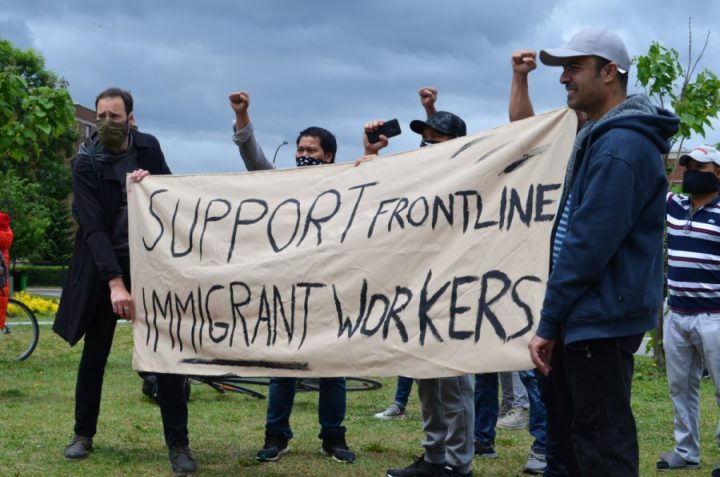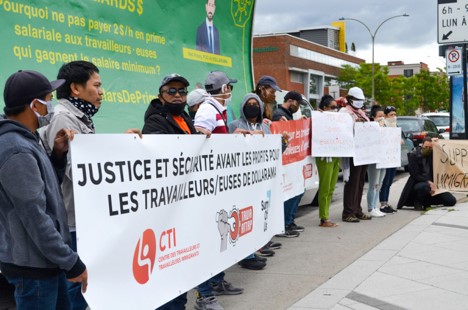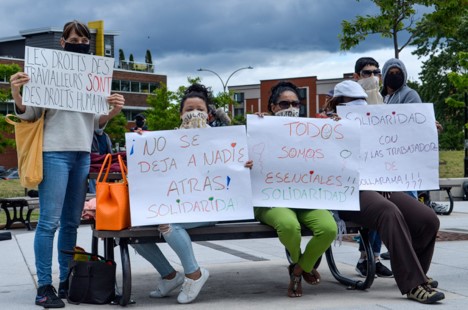On March 24, 2020, when much of the city was placed under confinement at the beginning of the pandemic, a select number of businesses were categorized as “essential.” Some of these companies, you would assume at first glance, were indeed indispensable: food and beverage places, grocery stores, pharmacies. But what about the others classified as essential – good-sized companies that sold a certain volume of food? One example is Amazon, operating across Europe and North America. Another is Dollarama, usually operating more locally. Other businesses subsequently classified as essential were delivery platforms such as Uber and Foodora, which grew to significant importance during the pandemic.
The pandemic also confronted society with the nature of work. It highlighted the essential workers doing frontline work that was crucial for society’s survival, and those who were able to work from home. New York governor Andrew Cuomo called the pandemic “the great equalizer,” for regardless of class, race and gender, all were to be equally impacted by the virus and its outcomes. Across Europe and North America, however, nothing could have been further from the truth. From the outset of the pandemic, the role played by essential workers in the global and local economy was clear.
In normal times, essential workers are for the most part invisible, but during the pandemic they became “heroes” and “guardian angels.” Our society’s survival depended on this vast army of immigrants and migrants working under difficult conditions in the lowest-paid jobs. They were ensuring the basic functioning of our societies. There was a desperate plea by employers, when confinement measures were imposed and borders closed, for people to replace migrant workers in the agricultural sector, immigrant workers in meat-processing plants, healthcare workers such as patient attendants (some of whom paid the ultimate price with their lives), delivery drivers, cleaners, and behind-the-scenes workers in mass warehouses who ensured that all goods flowed from overseas to the stores or directly to our homes. The warehouse sector, like other essential industries, is comprised primarily of a low-wage immigrant and racialized workforce that was hit especially hard by poverty and suffered the most dire consequences of the pandemic. This was the case with UBER Eats drivers, Amazon warehouse workers, and Dollarama distribution centre workers.
Logistics revolution: the mutation of neo-liberal globalization into warehouse “factories”
The logistics of warehouses and the distribution process may seem benign, and the simple act of optimizing speed and delivery may seem secondary to the major transformations in our global and local economy. Yet, while the key pillars of global capitalism are the financialization of capital, global supply chains, and just-in-time production, its last frontier is logistics.
Companies that understood this, like Amazon and Walmart, have become the largest corporations in our time. Walmart is seen as the pioneer of neoliberal logistics. It invented the “cross docking” model of rapid distribution through a series of warehouses and larger distribution centres that are linked through “radio identification tags.” They make use of satellites that enable real-time information to be relayed from store to warehouse to supplier, thus creating a system of lean logistics. This gives Walmart a massive edge over its competitors, making it the largest retailer on the planet.
The advent of the Web 2.0 and the rise of platforms and e-commerce only heighten the central role of logistics in global capitalism. The increasingly complex supply chains that source cheaper goods are based on just-in-time production and deregulated labour markets. This has prompted modern corporations to restructure their logistics, creating a flexible, low-paid and exploitable workforce across warehouses and distribution centres.
According to an article by Michael Grabell in ProPublica:
The people here are not day labourers looking for an odd job from a passing contractor. They are regular employees of temp agencies working in the supply chain of many of America’s largest companies – Walmart, Macy’s, Nike, Frito-Lay. They unload clothing and toys made overseas and pack them to fill our store shelves. They are as important to the global economy as shipping containers and Asian garment workers.
A local example in Montréal that we can relate to is Dollarama, one of the largest retailers in Canada with over 1,200 outlets and annual sales of $3.78 billion. The owners are now the 50th richest family in Canada. Yet most of Dollarama’s racialized immigrant workforce receives an average wage of between $13.50 to $14.75 per hour. The Rossy family has built its fortune on the extreme exploitation of workers from its stores, distribution centres and warehouses—an unfortunately familiar dynamic experienced by workers at Amazon as well.
Dollarama operates a spokes-and-hub model like Walmart. It operates six warehouses and a central distribution centre, with a quota of shipping 2 million boxes per week. The warehouses employ only temporary placement agency workers or perma-temps who are disposable and have no access to basic rights. Dollarama can then shirk all responsibility for unsafe working conditions. In Dollarama’s distribution centre, there are almost 1,000 such workers hired by temporary agencies. Nearly all are racialized and many are refugee claimants, with little access to health and safety measures or protective equipment. They risk exposure to the virus and come under heavy pressure from the employer, who shows disregard for anything other than profits.
Such dynamics, as typified in the extreme by Dollarama, are part of a broader trend in the logistics and warehousing sector. Montréal is considered to be the 4th largest logistics hub in North America, after Chicago, Los Angeles and New Jersey. It can ship goods within 24 hours to roughly 100 million customers. This makes it a central node in global capitalism. And Montréal’s further importance, since the signing of the Canada European Free Trade Agreement and the United States Mexico and Canada Free Trade Agreement (NAFTA 2.0), is that firms can ship to Canada from Europe and thereby have access to a broader North American market. The logistics and warehouse sector in Montréal employs nearly 100,000 workers. They include those working at the port, in trucking companies, warehouses, freight companies and third-party logistics firms such as Purolator, Intelcom, and DHS.
Shifts to online shopping have turned warehouses and distribution centres into the back mall of global capitalism. Employment in warehousing and storage nearly doubled over a 10-year period and the rising demand for warehouse employment increased the ranks of the working poor by 30% in Montréal from 2001-2012. In 2011, between 3,000 and 4,250 agency employees worked in warehouses throughout Québec, over three-quarters of whom lived and worked in the greater Montréal area. These warehouse employees represented 10% of the total number of workers employed by agencies in Québec. And given that temporary employment has skyrocketed since then, this figure is now significantly higher.
A 2019 report compiled by the Immigrant Workers Centre found that in a sample of 50 warehouse workers, all were immigrant workers, 90% were temporary placement agency workers, and many of them faced unsafe work conditions. These realities are by no means coincidental. They illustrate how the logic of profit-making pervades and determines who is employed and the working conditions they face.
The fact that the warehousing/logistics sector targets immigrant workers is part of the internal logic of the sector. These companies are in the business of moving goods and organizing the distribution of those products. They do not actually manufacture or produce anything. Competition between companies to move products as quickly and cheaply as possible (the only way to survive in a sector with extremely low profit margins such as retail), also creates downward pressures to control the cost of labour. This dynamic has led to an explosion of inequality, witnessed in the hierarchical structure of companies like Amazon and Dollarama and, as a result of their role and practices, in our contemporary world.
The intersections of race and class in the logistics sector
For logistics and warehousing to be profitable, labour has to be cheap and disposable. To ensure this, many of the agencies require a docile and disposable workforce and rely on workers whose status is precarious. According to the Immigrant Workers Centre’s report on warehouse work, of the workers surveyed, 38% were from Africa and 31% were from Haiti. South of the border, Amazon warehouses and distribution centres in Minneapolis largely employ new immigrants from East Africa. In Chicago’s warehouse industry, the workforce is comprised exclusively of black and Latino workers.
The role the agencies play is not just to ensure a disposable workforce but to actively recruit immigrant and migrant workers. In Montréal, the distribution hubs in Ville Saint-Laurent and Lachine are a testament to this fact. Dollarama’s warehouse and distribution centres are manned exclusively by immigrant workers. Many are recent refugees who came over the border from the United States after the election of Donald Trump. Others come from Nigeria, Haiti, and Guinea. And a new wave of refugees and migrant workers recruited under international student visas is from India.
These workers now make up the growing populace of the working poor. Despite working 40 hours a week, they continue to live in poverty. In Montréal, the epicentre of the COVID-19 pandemic in Canada, the virus has devastated two neighbourhoods: Montréal-Nord and Parc-Extension. Both share a common story, as two of the most impoverished neighbourhoods in Canada, with a significant rate of working poverty. Many of the residents are low-wage workers in essential services, who have to contend with inadequate housing, a lack of services, and precarious access to healthcare.
These workers remain unorganized because of the challenges faced by unions in organizing such an unstable workforce and in dealing with employers who are bent on staving off any union presence. Workers as well, because of their precarious status, will at times accept such conditions out of fear of what might become of their immigration applications, or out of sheer necessity, given their pressing need to work to feed themselves and support their families in Haiti, India, the Philippines and other parts of the world. All these factors make it immensely difficult to find ways to improve conditions. Given the pandemic, however, the situation has pushed workers to challenge such conditions. When faced with the prospect of falling ill or facing death to ensure their employer’s profits, workers have spoken up and organized.
The conditions of immigrant workers in warehouses
For many immigrants and refugees, warehouse work becomes an easy entry into the labour market. Warehouses are considered a low-road job, meaning low-skilled with high turnover, making it relatively easy for them to find work through temp agencies as long as they provide their own safety boots (despite that being an illegal employment condition). Such warehouses are highly racialized, with a workforce that is primarily immigrant and a management cadre that is invariably not.
These jobs start at the crack of dawn, and workers commute for an hour each way to Lachine, Dorval or Ville Saint-Laurent. For them, work dictates every aspect of their day, given the pressures of ensuring speedier processing. Workers are given impossible quotas. At Dollarama’s distribution centre, a worker will be given a daily quota of 14 pallets of goods to be shipped to different stores. This quota, when broken down by the second, means that workers have to move a box weighing up to 20 kilos every 20 seconds for the entire duration of their shift. There is no downtime or respite. This results in workers taking on riskier tasks and being forced to cut corners to meet their quota in order not to lose their jobs. As one worker commented about working conditions, “I was surprised that in an industrialized country like Canada, you could have places where people work more than machines.”
The anecdotes shared by workers tell of the extreme pressures they face. They recount urinating in bottles to avoid losing time by going to the bathroom. The breaks they have are a luxury, but due to the massive size of these warehouses, workers are unable to have a full 15-minute break simply because it takes 10 minutes just to walk off the floor. Such workplaces offer no dignity, as most workers are hired by temp agencies, leaving the employers free to exploit with impunity. Such impunity causes anger and conflict. In one instance, an employee who had been working at a warehouse for three years was dismissed without notice, the same day. In another instance, a worker complained that a very new employee had been promoted to a higher position. These workers were made to feel less than human in such places, but because of their status or precarity, were forced to accept such conditions.
Warehouse work and the pandemic
In late March, when cases began to skyrocket, it became clear all across Europe, the U.S. and Canada that the ones most affected were the immigrant working poor. For governments, one of the immediate tasks was to hold employers accountable to ensure that lives were protected and minimum health and safety standards for COVID-19 were enforced. The Immigrant Workers Centre (IWC) began to distribute flyers to inform people about their labour rights, their right to refuse work, and eligibility for the Canadian Emergency Response Benefit (CERB).
At the beginning of the pandemic, COVID-related protective measures were much weaker and did not include the provision of masks or gloves. Even in large warehouses, the two-metre distancing rule was not mandatory unless workers were close together for more than 15 minutes. The Immigrant Workers Centre took its first step in doing outreach, providing masks and informing workers of their rights through pamphleting—all with the aim of bombarding the Québec Labour Standards Commission and goading it to act.
Protective measures were slow in coming, but management reprisals were not. Workers at Dollarama were punished for organizing to get management to ensure more social distancing. In one case, a worker with 3 years’ service was fired for trying to help his coworkers apply public health directives. A management policy had resulted in workers’ lunches being placed in a single fridge, leading to lineups and crowding. This made workers nervous and they began to organize inside the warehouse to reverse the policy, in order to have more physical distancing. They approached the worker who was employed as a trainer, and he then went to the supervisors to inquire about the situation. At the end of his shift, he was fired by his temp agency.
In discussions with the Immigrant Workers Centre, the fired worker noted how little regard the company had for the workers’ safety and health, and for their basic rights. “I had worked there three years. I’m not a thief, I’m not a dog, I just wanted to be safe,” he said. “I just wanted my co-workers to be safe.” He and other workers decided to take action. Added pressure was applied by warehouse workers, who spoke up for better health and safety conditions at a press conference organized by the Centre. Giving in to worker pressure, Dollarama began to distribute masks and gloves.
Across various warehouses including those in Amazon distribution centres, where outbreaks of the virus took place, similar actions were reported. In the U.S., workers walked out of an Amazon “fulfilment” centre in Long Island, New York. Recently, a blockade of Black Lives Matter protesters surrounded another Amazon facility in the San Francisco Bay area to demand better health and safety measures to protect workers.
For immigrants, the pandemic remains a real threat. In Montréal, by the middle of June there were 35 different workplace outbreaks of COVID-19, many of which occurred in workplaces with a primarily immigrant workforce. Québec public health statistics show that 20% of all transmission of the virus is workplace-related. This fact remains the key preoccupation of workers and their communities: how to ensure that workplaces remain safe when employers feel that they can act with complete impunity, even if their workforce is at risk.
Despite the economic and public health crisis, retail e-commerce sales reached a record $3.9 billion in May in Canada (Statistics Canada). In another frame put forward by Financial Times, “Amazon became the emergency port of call for those desperate to stock up on vital household goods — a rush that led the company to temporarily shut its warehouses to ‘non-essential’ products. Record revenues followed….” Other firms that were able to leverage their logistics and online sales also attained record profits. Loblaws reported $240 million in profits in the first quarter ending March 29. Dollarama reported sales of $844.8 million and $86.1 million in earnings from April to June. Yet many of the thousands of immigrant workers who continue to carry out essential jobs are left behind.
The workers at Dollarama were able to extend their hazard pay of 10% until the beginning of August, and the deadline was extended until the end of October as a result of the campaign led by workers and supported by the IWC. Workers, though, will once again be making less than the $15/hour minimum wage needed to escape working poverty. Similar decisions to cut hazard pay were made by other corporations such as Walmart, Loblaws and Provigo, with little consideration of the risks associated with the ongoing pandemic. Workers are now left vulnerable as they are thrown back into working poverty, and continue in fear of a continuing pandemic. These conditions have left workers angry and volatile, but they have immense potential power and leverage to not only exact short-term gains but to also transform our society.
The great transformations confronting us as capitalism mutates and finds new paths for generating profits will continue to create new struggles and ways of organizing. We are now in a world where the logistics and warehouse sector has concentrated workers in a way that few predicted. Many pundits dismissed the idea of workers organizing in the era of gig work and the digital economy, arguing that those conditions would only lead to the erosion of workplaces. But in fact, platform capitalism has led to the opposite outcome by concentrating workers in such distribution centres, the “choke points” of global capitalism.
Employers are all too aware of the stakes involved, and have used every tool at their disposal to reduce the possibility of these workers exercising their collective power, from the use of subcontracting and temp work, to threats involving people’s immigration status and other forms of intimidation. For us, it is clear that to support these workers, we have to build broad campaigns for status and the right to permanent work. Campaigning for a $15 minimum-wage would be a direct act of solidarity, giving workers the ability to challenge their employers for decent conditions and wages.
Deeper reflection is needed, though, to understand how we arrived at the point where someone like Jeff Bezos is set to become the world’s first trillionaire? The companies that profited generously from the logistics revolution did not do so because of a technological revolution or innovation. They amassed wealth from their ability to create a precarious, low-wage workforce. In many respects, these companies have also relied heavily on publicly-funded infrastructure such as highways, ports, railways and Canada Post, and on various tax incentives.
The shift to increasingly centralized forms of distribution begs the question: should we be nationalizing companies responsible for the distribution of goods? Could that model offer us a way to ensure a more equitable society, where such extreme gaps in wealth cease to plague us in a succession of crises involving our climate, our health, and the economy? Perhaps those who migrated to seek a better future could have the option of making their life in their chosen homeland.












